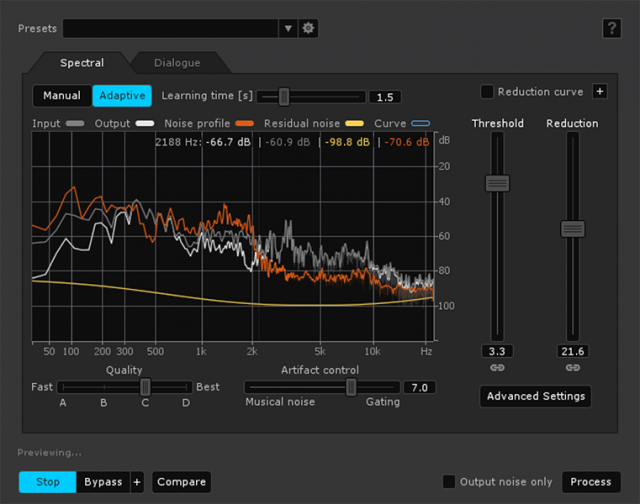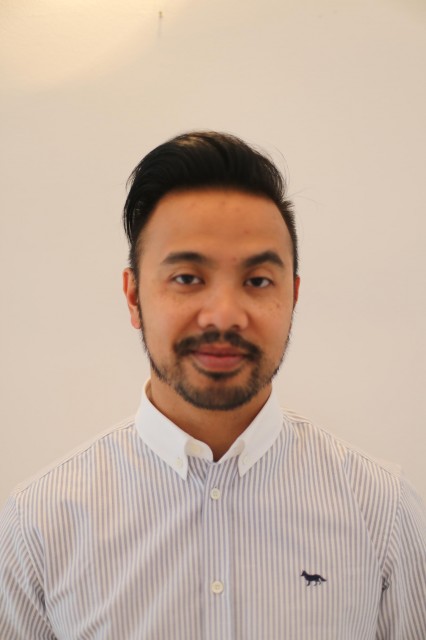It’s sometimes tough to write about audio tools precisely because they tend to bundle together a lot of features. So let’s step back and consider why they tend to do all of those things.
With audio repair, it’s a pretty easy explanation. From your perspective, your sound is $#*$#ed up. You want to get it un-$#*(&ed up.
Of course, in reality, there are tons of variables. The context can change: You might be repairing sound from a recording of instruments. You might be fixing dialog. You might know what you’re doing – even on big-budget TV and film, recordings can wind up with sound problems. Or, let’s be honest, you might kind of have no clue what you’re doing and wound up with $(&*ed up sound because you yourself $#(*&ed it up. (Uh… yeah, been there.)
The underlying problems can be varied, too – even in a single recording. Different takes didn’t match. There’s hum. There’s noise. There are unwanted sounds.
So, all of this is to say, over the years I’ve seen a number of general purpose repair toolkits, along with specialized toolkits. Right now, the one iZotope makes is special in that it bundles all the things you might ever need to fix audio into a single toolset that can work for more or less anyone. It doesn’t entirely eliminate the utility of more specific tools here and there – some of which may already be in some form in your DAW. But the tools are unusually advanced, unusually complete, and I think at the moment there simply isn’t anything else that does as much. If this is a First Aid Kit for sound, it’s kind of also a fully-staffed Emergency Room and Operating Room. Not like a field hospital. Like Mount Sinai.
I’m going to be talking a bit about iZotope this month partly because I’ve noticed that this year, they’ve shifted focus a bit from just reeling off features to talking about what they were doing in the first place. So I had a chat with them about RX and Ozone, in particular, two of their flagships, and it led to this.
RX4 is particularly useful in TV and film production because of the likelihood those users need to fix stuff – more on that in a moment. But it is worth considering in a production environment if you ever record anything for any reason.
Among other tutorials, iZotope have produced two videos that nicely illustrate what I mean by that.
First, this tutorial is great, because rather than the typical software demo sound, it’s — well, it’s awful. Buzz and cough and bangs — I’m sure this sounds familiar. To be honest, this is the point where iZotope RX becomes necessary, because otherwise you’re probably better off just going back and re-recording. What you can see is that the toolset of RX can be a musical one.
Even more in the musical direction, another interesting video from February released by iZotope deals with how to combine multiple takes that don’t match sonically. Here, the approach is potentially as creative as it is remedial; you get the opportunity to merge takes that otherwise wouldn’t fit.
I spoke to iZotope a bit about how they find users working with their tools, and they were willing to share exclusively with CDM a brief interview they did with Christian Beneventura, a re-recording mixer and engineer. That’s a fairly specific job – though also a reminder of the range of industrial gigs available to people with a solid sound/music background. (Use those ears, in other words.) Mr. Beneventura has an amazing resume, as you’ll see on IMDB, including The Vampire Diaries, Choke, Glee, and now Daredevil and The Following. (In fact, if you haven’t at some point heard his dialogue editing, you probably haven’t switched on your TV or Netflix lately, it appears.)
And he’s worked out how to deal with sounds in New York.
This is not some sort of advertisement for the product; to me, it’s interesting to hear this stuff and see how it works on production. Interview courtesy iZotope and Sean Greenhalgh:
Why do you think you’ve been successful at your chosen craft while others have burned out or faded away?
I believe I’ve been successful because I’m constantly trying to get better at it everyday. Even though I have been doing this for quite some time, it’s important not to get complacent. I’m always trying to research and try new plug ins or try different techniques to get faster and more efficient. It’s important to keep learning and evolving because the technology does so.
Daredevil seems to be a very dynamic sounding show. Was this a conscious decision?
It was a conscious decision. From the very beginning, we knew that sound was going to play a huge part of this show. The character of Matt Murdock is blind and trying to convey how his other senses help him “see” especially sonically, is very critical to the show. I think every part of Daredevil’s soundscape was deliberate. Creating the backgrounds of Hell’s Kitchen, deciding what exactly Matt Murdock hears in the flurry of city chatter, having the rate of the heartbeats that Matt hears hit at exactly the right points. Every part of the editing and mixing process was very meticulous and we are very proud of how everything turned out.
Why do you use RX?
I use RX because it’s a life saver. There are many scenes that I have cut that would not have been possible unless I had RX Spectral Repair. RX has really changed the way I edit because I have integrated using the plug in within my editing routine. When I first began using it, I thought it was the future. “How can you not edit with this?” I said to myself and colleagues. RX is so reliable and I know what it’s going to do for me. Brake squeals or back up beeps, no problem. Lavalier mic cutting off or boom mic bump, got it covered. I use every single plug-in in RX because it’s reliable and I know it will get the job done.
What are some of the challenges of working on audio recorded in NYC?
Dealing with audio that’s been recorded in New York can be tough because of the pure fact the city is inherently noisy. Extraneous city sounds that you can hear when dialogue is being spoken is always a pain to take out. The traffic, brake squeals, people talking and shouting, music bumping from cars, New York will find a way to make a scene difficult to edit. RX spectral repair has always helped me in this bind. I could easily see brake squeals to take out over dialogue as well as people who talking who aren’t supposed to. I did work on a scene where it took place at Washington Square Park and there was a street performer drumming and singing over the dialogue and they didn’t want to ADR the actor. Sounds impossible to do but Spectral Repair and some fancy editing helped me achieve that.
Of course, to me, this is doubly interesting precisely because I’m not experienced at this stuff, nor many of the people I know. Sound we record for a video production is necessarily going to have problems because it’s not my area. And since I can’t afford someone like Christian, we have to DIY if I want to fix it. Ditto instrumental recordings. To me, the software doesn’t replace those skill sets – on the contrary, when you do have to learn this stuff yourself, you appreciate why those folks are so valuable. And, if you are willing to invest the time, you might even find a professional path you would otherwise not expect; there is huge need for people who are skilled to solve these problems.
I haven’t found anything coming close to what iZotope’s tools can do, but I would love to ask our readers – particularly any of those working in these industries – what you use. RX? Other tools? A combination? Let us know.
See also the excellent Designing Sound which covers these topics more regularly:
http://designingsound.org
While it won’t turn you into a TV sound editor overnight, if you want to take your first baby steps toward fixing the problems above, iZotope has some videos for that, too:
And for more on RX4 itself, our friends at Sonic State did a great video tour of what’s in this tool:

